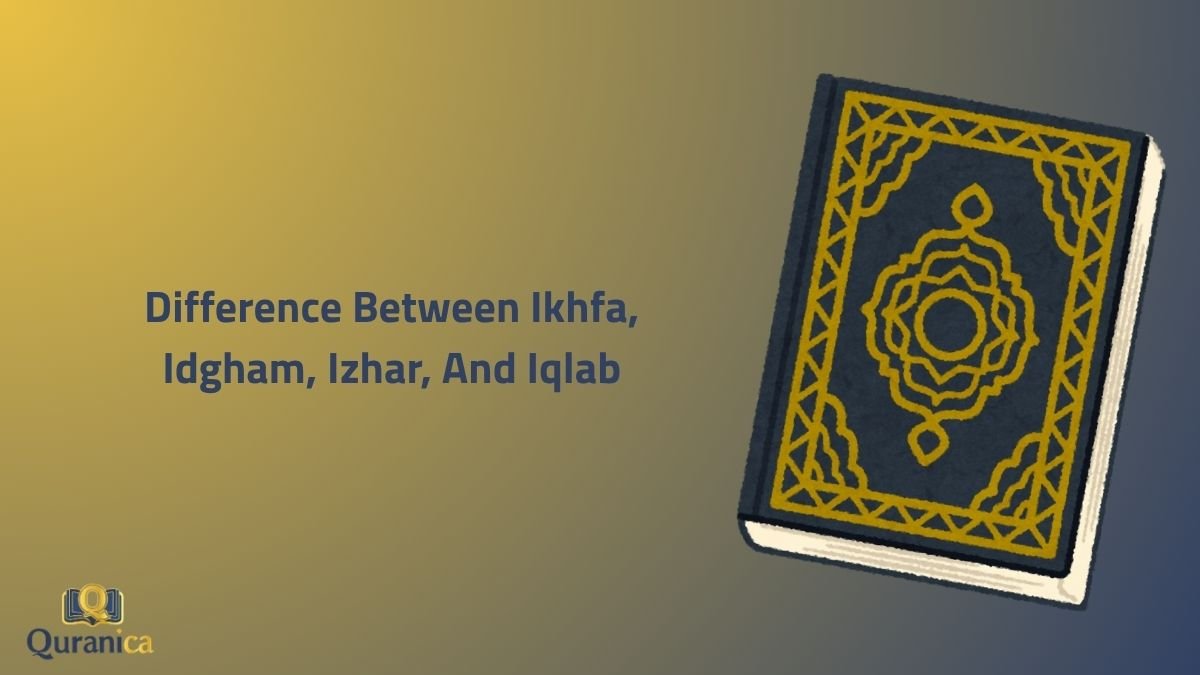Tajweed includes four vital rules—Izhar, Idgham, Iqlab, and Ikhfa—that shape how the silent ‘n’ sound from Noon Sakinah and Tanween is pronounced in Quranic recitation. Izhar keeps the sound clear before throat letters, while Idgham merges it into specific letters with or without a nasal tone. Iqlab flips the sound into a soft ‘m’ before Baa, and Ikhfa gently hides it before fifteen other letters, adjusting tone based on the next letter’s weight.
When you listen to a skilled Qari (reciter) reading the Quran, you hear a beautiful, flowing melody. That melody is governed by a precise science of pronunciation called Tajweed.
If you want to recite the Quran with the beauty and precision it deserves, understanding the rules of Noon Sakinah and Tanween is one if your most important steps.
These rules are the key to appreciate the correct pronunciation of thousands of words in the Quran, transforming your recitation from hesitant to confident.
The Foundational Rules of Noon Sakinah and Tanween in Tajweed
Before we delve into the specifics of Idgham Ikhfa Iqlab Izhar, we must first understand two key concepts: Noon Sakinah (نْ) and Tanween (ـًـٍـٌ). They are the heart of these rules.
A Noon Sakinah is simply the letter Noon (ن) with a sukoon (ـْـ) on it, which means it carries no vowel sound. It is a silent ‘n’.
Tanween, on the other hand, is the double vowel marking you see at the end of some words, appearing as fathatain (ـً), kasratain (ـٍ), or dammatain (ـٌ). Though written differently, Tanween also produces a silent ‘n’ sound.
The beauty of Tajweed lies in how we treat this silent ‘n’ sound. Its pronunciation changes depending on the very next letter that follows it.
This leads us to the four essential rules we are about to explore: Izhar (Clarity), Idgham (Merging), Iqlab (Flipping), and Ikhfa (Hiding).
What is Izhar in Tajweed?
Let us begin with Izhar, a word that in Arabic means “clarity” or “to make clear.” This rule is perhaps the most straightforward of them all, as it asks us to do exactly what its name suggests.
When the rule of Izhar is applied, you pronounce the ‘n’ sound of the Noon Sakinah or Tanween distinctly and clearly.
There is no merging, no hiding, and no prolonged nasal sound (ghunnah). You simply pronounce the ‘n’ sound as it is, cleanly and crisply.
The Letters of Izhar (Huroof al-Halqi)
The rule of Izhar is applied when the Noon Sakinah or Tanween is followed by one of six specific letters. These letters are known as the Huroof al-Halqi, or “the throat letters,” because their point of articulation is in the throat.
The six throat letters are:
- Hamza (ء)
- Haa (هـ)
- ‘Ayn (ع)
- Haa’ (ح)
- Ghayn (غ)
- Khaa (خ)
When you see a Noon Sakinah or a Tanween followed by any of these six letters, you must pronounce the ‘n’ sound with complete clarity.
Types of Izhar
While Izhar is fundamentally about clarity, it is worth noting that it can occur in different contexts. The three main Izhar types are:
- Izhar Halqi (Clarity from the Throat),
- Izhar Shafawe (Clarity of the Lips),
- Izhar Mutlaq (Absolute Clarity).
The most common type, and our focus here, is Izhar Halqi, which we’ve just discussed—applying clarity before the six throat letters.
There are other, more absolute forms of Izhar, but for a beginner, mastering Izhar Halqi is the perfect and most crucial starting point.
Examples of Izhar from the Quran
Let’s look at some beautiful examples from the Quran to see Izhar in practice. Notice how the ‘n’ sound is present and clear.
“عَذَابٌ أَلِيمٌ”
‘azaabun aleem
A painful punishment.
Here, the Tanween on the letter ‘ba’ (بٌ) is followed by the Izhar letter Hamza (أ), so the ‘n’ sound of the Tanween is pronounced clearly.
“مِنْ خَيْرٍ”
min khayr
from any good.
In this case, the Noon Sakinah (نْ) is followed by the Izhar letter Kha (خ), requiring the ‘n’ sound to be pronounced distinctly.
“فَرِيقًا هَدَىٰ”
fareeqan hadaa
A party He has guided.
The Tanween on the letter ‘qaf’ (قًا) is followed by the Izhar letter Haa (هـ), so the ‘n’ sound is pronounced clearly without any nasalization.
For those just starting this blessed path, understanding concepts like Izhar is the first step.
To support your learning, our Quranica’s Learn Tajweed for beginners Course provides a solid and gentle foundation in these core principles, helping you build your skills with confidence.

What is Idgham in Tajweed?
Now, we move to our second rule, Idgham. In Arabic, Idgham means “to merge” or “to assimilate.” This rule is the opposite of Izhar. Instead of pronouncing the ‘n’ sound clearly, we merge it into the letter that follows it.
When you apply Idgham, the Noon Sakinah or Tanween sound flows into and becomes one with the next letter.
The tongue moves directly to the articulation point of the following letter, effectively skipping over the ‘n’ sound’s usual point of articulation.
The Letters of Idgham
The rule of Idgham applies when Noon Sakinah or Tanween is followed by one of another set of six letters. These letters are conveniently collected in the mnemonic word يَرْمَلُون (Yarmaloon).
The six letters of Idgham are:
- Yaa (ي)
- Raa (ر)
- Meem (م)
- Laam (ل)
- Waw (و)
- Noon (ن)
The Types of Idgham
Idgham is not a single, uniform rule. It is divided into two types, based on whether the merging is accompanied by a nasal sound (ghunnah) or not.
1. Idgham with Ghunnah (Idgham bi Ghunnah)
This type of Idgham involves merging the Noon Sakinah or Tanween into the next letter while holding a distinct, melodious nasal sound for about two counts. This happens when the Noon Sakinah or Tanween is followed by one of four letters.
These four letters are collected in the mnemonic يَنْمُو (Yanmu):
- Yaa (ي)
- Noon (ن)
- Meem (م)
- Waw (و)
2. Idgham without Ghunnah (Idgham bila Ghunnah)
This second type is a complete and total merging, without any accompanying nasal sound. The ‘n’ sound of the Noon Sakinah or Tanween is assimilated so fully that it disappears completely into the next letter.
This occurs with the remaining two letters from Yarmaloon:
- Laam (ل)
- Raa (ر)
Examples of Idgham from the Quran
Let’s see how both types of Idgham appear in the Holy Quran.
1. Examples for Idgham with Ghunnah:
“مَن يَقُولُ”
May-yaqoolu
“…those who say…”
The Noon Sakinah (نْ) is followed by Yaa (ي), so the ‘n’ sound is merged into the ‘y’ with a distinct nasal sound (ghunnah), becoming ‘may-yaqool’.
“وُجُوهٌ يَوْمَئِذٍ”
wujoohuy-yawma’izin
Faces, that Day.
The Tanween (ـٌ) on the letter ‘haa’ is followed by Yaa (ي), so the ‘n’ sound of the Tanween merges into the ‘y’ with ghunnah.
2. Example for Idgham without Ghunnah:
“مِن رَّبِّهِمْ”
mir-rabbihim
from their Lord
The Noon Sakinah (نْ) is followed by Raa (ر), so the ‘n’ sound is completely merged into the ‘r’ without any nasalization. It is read as ‘mir-rabbihim’, not ‘min-rabbihim’.
“هُدًى لِّلْمُتَّقِينَ”
hudal-lilmuttaqeen
a guidance for the righteous.
The Tanween on the ‘dal’ (دًى) is followed by Laam (ل). The ‘n’ sound of the Tanween is completely assimilated into the Laam without ghunnah.
Mastering the beautiful nuances of Idgham is a key step forward in your recitation. For students who wish to perfect this and other advanced rules, we warmly invite you to explore Quranica’s Advanced Tajweed Course, where these details are polished.

What is Iqlab in Tajweed?
We now arrive at our third rule, Iqlab. The word Iqlab in Arabic means “to flip” or “to convert.” This rule is unique and easy to identify because it applies to only one letter of the Arabic alphabet.
Iqlab is the gentle flipping of the Noon Sakinah or Tanween sound into a light Meem (م) sound, accompanied by a soft ghunnah (nasalization). It is a beautiful transformation of sound that adds a particular melody to the recitation.
The Rule of Iqlab
The rule of Iqlab is wonderfully simple. It occurs whenever a Noon Sakinah (نْ) or Tanween (ـًـٍـٌ) is followed by the letter Baa (ب).
When this happens, the ‘n’ sound is no longer pronounced. Instead, it is converted into a soft ‘m’ sound, which is then held for about two counts with ghunnah.
How to Pronounce Iqlab
To pronounce Iqlab correctly, you bring your lips together very gently, as if you are about to say the letter Meem (م), but without applying firm pressure.
From this light touch of the lips, you produce the ghunnah, the nasal sound, for two counts.
Then, you proceed to pronounce the letter Baa (ب) with its vowel. The sound is a soft “m-b,” not a hard “n-b.”
Examples of Iqlab in the Quran
Let’s listen with our hearts to these examples from the Quran.
“لَيُنۢبَذَنَّ”
layum-bazanna
He will surely be thrown.
Here, the Noon Sakinah (نْ) is followed by the letter Baa (ب). The ‘n’ sound is flipped to a Meem (م) sound with ghunnah, and you can even see a tiny ‘م’ written above the Noon in many Mushafs to signify this rule.
“إِنَّهُۥ عَلِيمٌۢ بِذَاتِ ٱلصُّدُورِ”
Innahu ‘aleemum bidhāti aṣ-ṣudūr
“Indeed, He is Knowing of that within the breasts.”
Here, عَلِيمٌ بِذَاتِ (‘aleemun bidhati) is pronounced ‘aleemum bidhati. The ‘un’ sound becomes an ‘um’ sound.
What is Ikhfa in Tajweed?
Finally, we come to Ikhfa, which means “to hide.” This is the most frequent of the four rules because it applies to the largest number of letters.
Ikhfa is a delicate balance, a state between the clarity of Izhar and the full merging of Idgham.
When the rule of Ikhfa is applied, the ‘n’ sound of the Noon Sakinah or Tanween is not pronounced clearly, nor is it fully merged.
Instead, it is lightened or “hidden,” and a ghunnah is held while the mouth prepares to articulate the next letter.
The Letters of Ikhfa
Ikhfa applies to the fifteen letters that remain after we account for the letters of Izhar, Idgham, and Iqlab. They are:
- Taa (ت)
- Thaa (ث)
- Jeem (ج)
- Daal (د)
- Zaal (ذ)
- Zay (ز)
- Seen (س)
- Sheen (ش)
- Saad (ص)
- Daad (ض)
- Taa’ (ط)
- Zaa’ (ظ)
- Faa (ف)
- Qaaf (ق)
- Kaaf (ك)
The ghunnah of Ikhfa takes on the quality of the subsequent letter.
If the letter is a “heavy” or “full-mouthed” letter (like ق, ص, ض, ط, ظ), the ghunnah will also have a heavier sound.
If the letter is a “light” letter (like ت, ك, س), the ghunnah will have a lighter, thinner quality.
This nuance comes naturally as you prepare your mouth for the next sound.
Examples of Ikhfa in the Quran
Let us observe the gentle hiding of the ‘n’ sound in these Quranic verses.
“إِن كُنتُمْ”
in kuntum
if you should be
The Noon Sakinah (نْ) is followed by Kaaf (ك), a light letter. The ‘n’ sound is hidden with a light ghunnah as the tongue prepares for the ‘k’ sound.
“رَجُلًا سَلَمًا”
rajulan salaman
a man devoted
The Tanween on the letter Laam (لًا) is followed by Seen (س), another light letter. The ‘n’ sound is hidden with a light ghunnah.
مِن قَبْلُ
min qablu
from before
Here, the Noon Sakinah (نْ) is followed by Qaaf (ق), a heavy letter. The ‘n’ sound is hidden with a fuller, heavier ghunnah, reflecting the nature of the Qaaf.
Difference Between Izhar Idgham Iqlab Ikhfa in a Comparison Chart
As we journey through these beautiful rules, it can be helpful to see them side-by-side. This allows the connections and differences to become even clearer in our minds.
Think of the following chart as a simple map, summarizing the paths you can take when you meet a Noon Sakinah or Tanween in your recitation. It is a quick reference to reinforce your learning.
| Rule | Meaning | Action on the ‘n’ Sound | Letters Involved | Ghunnah (Nasal Sound)? |
| Izhar (إظهار) | To Make Clear | Pronounce the ‘n’ sound distinctly and plainly. | The 6 Throat Letters: ء, هـ, ع, ح, غ, خ | No ghunnah. |
| Idgham (إدغام) | To Merge | Merge the ‘n’ sound into the next letter. | The 6 Letters in يرملون: ي, ر, م, ل, و, ن | Yes (with ي, ن, م, و). No (with ل, ر). |
| Iqlab (إقلاب) | To Flip/Convert | Flip the ‘n’ sound into a soft Meem (م) sound. | The letter Baa (ب). | Yes, a light ghunnah is held. |
| Ikhfa (إخفاء) | To Hide | Hide the ‘n’ sound, pronouncing it lightly between Izhar and Idgham. | The remaining 15 letters. | Yes, a ghunnah is held for two counts. |
Common Mistakes to Avoid When Pronouncing Izhar, Idgham, Iqlab, and Ikhfa
As with learning any new skill, you will encounter small hurdles on your path to perfecting the rules of Noon Sakinah and Tanween.
This is a natural part of the journey. Seeing these common mistakes as signposts can help you correct your course with gentleness and precision.
Let us walk through some frequent errors so you can be mindful of them in your practice.
1. Common Mistakes in Izhar
The main error in Izhar (clarity) is not being clear enough. Some students accidentally add a short nasal sound (ghunnah) to the Noon Sakinah or Tanween out of habit.
Another mistake is making a brief, unnatural pause on the ‘n’ sound before moving to the next letter.
Remember, Izhar should be crisp and fluid; pronounce the ‘n’ clearly and move on smoothly.
2. Common Mistakes in Idgham
For Idgham with Ghunnah (merging with a nasal sound), the mistake is often in the timing. Learners may shorten the ghunnah, not holding it for the required two counts, which diminishes its beautiful sound.
For Idgham without Ghunnah (complete merging), the opposite can happen. A student might incorrectly add a slight ghunnah, especially when merging with the letter Laam (ل). The merge here should be complete and clean, with no trace of a nasal sound.
3. Common Mistakes in Iqlab
The most frequent error in Iqlab (flipping) is in the application of the lips. Many students press their lips together firmly when changing the ‘n’ sound to an ‘m’ sound.
The correct pronunciation requires a gentle, soft touch of the lips. This allows the ghunnah to flow properly without sounding like a stressed ‘m’.
4. Common Mistakes in Ikhfa
With Ikhfa (hiding), a common pitfall is pronouncing the Noon too clearly, making it sound more like Izhar.
The tongue should not fully touch the articulation point of the Noon; it should hover near the point of the next letter.
Another point of refinement is the quality of the ghunnah. Learners often use the same light ghunnah for all fifteen letters, forgetting that it should sound heavier for full-mouthed letters like Qaaf (ق) and lighter for thin letters like Kaaf (ك).
Read also: Ikhfa rules, Letters, And Types
Begin Your Perfect Recitation Journey with Quranica
Understanding these rules is the first step, but true mastery comes from listening, practicing, and being guided by a qualified teacher. At Quranica, we are dedicated to helping you on this sacred journey.
Our teachers are native Arab speakers and esteemed graduates of Al-Azhar University. They are not only experts in Quran, Arabic, and Tajweed, but are also highly experienced in teaching non-Arabs and hold Ijazah (certification) to teach the Quran.
We offer structured learning paths with competitive, affordable pricing, ensuring that authentic Quranic education is accessible to everyone. Explore our courses designed for every level:
- Learn Quran with Tajweed (for all levels)
- Quran Memorization (Hifz) Programs
- Ijazah Course
- Islamic Studies
- Ten Qirat
- Arabic Lessons for Beginners
Explore our full range of courses.
Join a Quranica course today!

Conclusion
Tajweed is the science behind the precise and melodic recitation of the Quran, and mastering the rules of Noon Sakinah and Tanween is essential for any learner. These rules—Izhar, Idgham, Iqlab, and Ikhfa—govern how the ‘n’ sound is treated depending on the following letter.
Izhar means clarity and occurs when the ‘n’ sound is followed by any of the six throat letters (ء، هـ، ع، ح، غ، خ), which are pronounced clearly without nasalization. It ensures the ‘n’ sound is crisp and distinct.
Idgham means merging and applies when the ‘n’ sound is followed by specific letters in the word Yarmaloon (ي، ر، م، ل، و، ن). It is split into two types: with nasalization (ghunnah)—for (ي، ن، م، و)—and without it—for (ر، ل).
Iqlab flips the ‘n’ sound into a light Meem (م) sound when followed by the letter Baa (ب). This transformation includes a gentle nasal tone and is marked in many Mushafs for easy recognition.
Ikhfa is the art of hiding the ‘n’ sound when followed by any of the remaining 15 letters. It combines a soft nasalization with a light or heavy tone based on the following letter’s nature, creating a smooth, graceful transition.








0 Comments